Can I Use a Trail Camera for Home Security? Best Options & Setup Guide
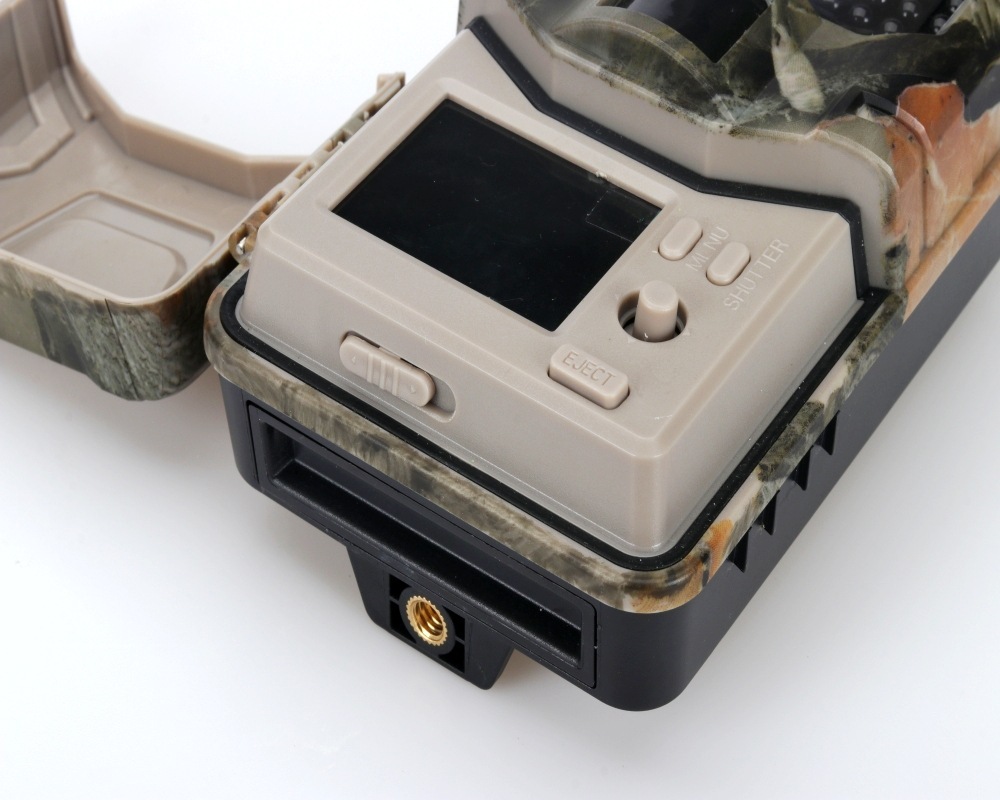
- Info and Tips
Can I Use a Trail Camera for Home Security? Pros, Cons & Best Practices
Yes, you can use a trail camera for home security, but it’s not a perfect replacement for a traditional security system. Trail cameras are built for outdoor use, making them great for monitoring backyards, driveways, and remote properties. They blend in easily, run on batteries, and can capture high-quality images, even at night.
But before you buy one, there are some things to consider. And we’re going to cover them in this blog. We’ll provide a clear answer to your question — can I use a trail camera for home security?
First Off, Let’s Talk About What Exactly Is a Trail Camera?
A trail camera is a motion-activated camera designed for outdoor use. Hunters and wildlife enthusiasts use them to track animals, but some people also use them for home security. These cameras automatically take pictures or record videos when they detect movement, even at night. Since they run on batteries and don’t need Wi-Fi or electricity, they work well in remote areas.
For home security, trail cameras are a budget-friendly way to monitor driveways, backyards, or entry points. They blend in with trees and bushes that make them harder to spot than traditional security cameras. However, they’re not perfect for every situation.
Here’s a quick look at a trail camera vs. security camera.
| Feature | Trail Camera | Security Camera |
| Main Use | Wildlife tracking, hunting | Home and business security |
| Power Source | Battery-powered | Wired or plugged in |
| Power Source | No Wi-Fi (unless cellular) | Wi-Fi or Ethernet |
| Real-Time Viewing | No (except some cellular models) | Yes, with live feed access |
| Motion Detection | Yes, triggers recording | Yes, with notifications |
| Storage | SD card | Cloud or local storage |
Pros of Using a Trail Camera for Home Security
Here’s why you should use a trail camera.
- Affordable Option: Trail cameras are much cheaper than traditional security systems. You can get a good one for under $100, while security cameras with all the bells and whistles can cost several hundred dollars.
- Battery-Powered & Wireless: No need to mess with wiring or power outlets. Trail cameras run on batteries, making them perfect for places where setting up a wired security camera isn’t possible.
- Stealth & Camouflage: Unlike security cameras, which are often big and obvious, trail cameras are designed to blend in. Their camo design makes them harder for intruders to notice, reducing the chances of someone tampering with them.
- Night Vision & Motion Detection: Most trail cameras come with infrared night vision, so they can capture movement even in complete darkness. This makes them great for monitoring driveways, sheds, or rural properties where lighting is limited.
Cons & Limitations of Using a Trail Camera for Home Security
While trail cameras are useful for home security, they’re not perfect. Here are some of the main drawbacks to consider.
- Limited Remote Access: Most trail cameras don’t connect to Wi-Fi, which means no live streaming or instant alerts. If something happens, you won’t know until you check the footage. Some high-end models have cellular connectivity, but they come with extra costs for data plans.
- Shorter Recording Storage: Unlike security cameras that upload footage to the cloud, trail cameras store everything on an SD card. If the card fills up, the camera may stop recording or overwrite older footage. You’ll need to check and clear the card regularly to ensure you don’t miss anything important.
- Slower Motion Detection: Trail cameras aren’t as fast at detecting movement as security cameras. Some may have a delay of a few seconds before they start recording, which means they might miss fast-moving intruders or important details.
- Legal Considerations: Privacy laws vary by location, and there are restrictions on where you can place cameras, especially if they capture areas beyond your property. Before setting up a trail camera, make sure you’re not violating any local laws regarding surveillance and recording.
5 Best Trail Cameras for Home Security
After comparing thousands of trail cameras, here are 5 best.
Tactacam REVEAL Pro 3.0
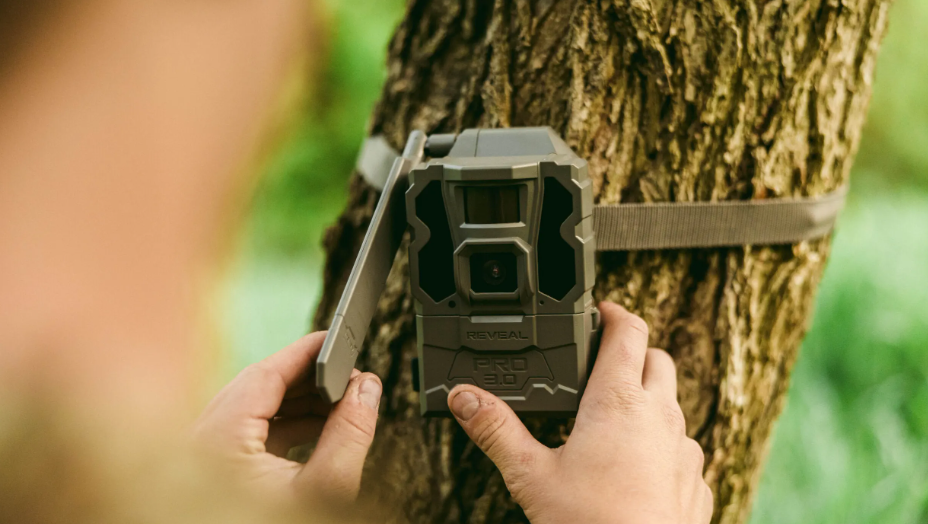
Image Source: OutdoorHub
Price: $154.99
The Tactacam REVEAL Pro 3.0 is a best trail camera for home security that is designed for remote monitoring. It features no-glow infrared flash technology that makes the camera’s flash invisible to wildlife and humans. The camera is equipped with a 2-inch LCD screen for easy setup and live aiming.
Key Features
- Captures 4K UHD photos and 1080p full HD videos.
- No-glow IR flash with a range exceeding 80 feet.
- Built-in GPS for location tracking.
- Auto carrier selection for optimal cellular connectivity.
- Internal storage with an optional SD card slot (supports up to 32 GB).
- Operates on 12 AA batteries (not included).
- Compatible with major cellular networks.
Tactacam REVEAL X 3.0
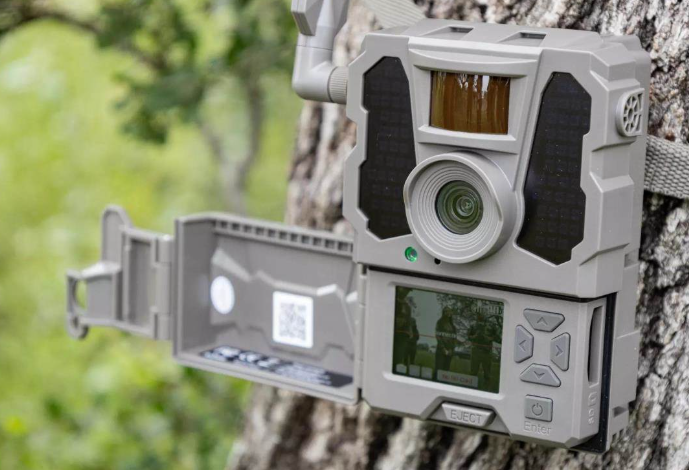
Image Source: Game & Fish
Price: $124.99
The Tactacam REVEAL X 3.0 is a cellular trail camera that provides real-time monitoring. It features low-glow infrared flash technology, which ensure discreet operation. The camera includes a pre-installed, durable antenna and built-in GPS for enhanced functionality.
Key Features
- Captures 4K UHD photos and 1080p full HD videos.
- Low-glow IR flash with a range of up to 96 feet.
- Built-in GPS for precise location tracking.
- Auto carrier selection for optimal cellular connectivity.
- Internal storage with an optional SD card slot (supports up to 32 GB).
- Operates on 12 AA batteries (not included).
- Compatible with major cellular networks.
Moultrie Mobile Edge 2
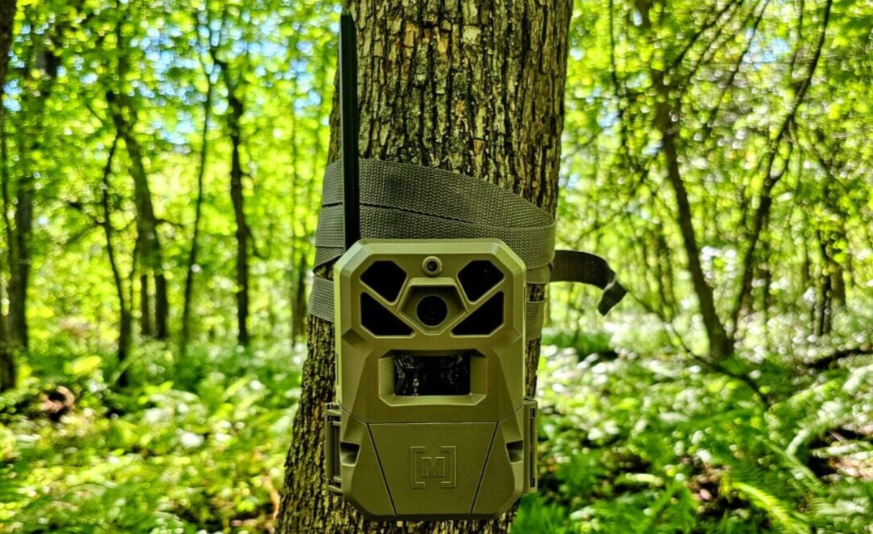
Image Source: AllOutdoor.com
Price: $99.99
The Moultrie Mobile Edge 2 is a trail camera designed for smooth connectivity and user-friendly operation. It automatically connects to the strongest cellular network available that ensures reliable performance in various locations.
Key Features
- High-resolution image capture.
- Internal memory with cloud storage options, eliminating the need for SD cards.
- Operates on 8 AA batteries, optimized for extended field use.
- Automatic network connectivity to the strongest available signal.
- User-friendly app for remote monitoring and settings adjustment.
SpyPoint Flex G-36
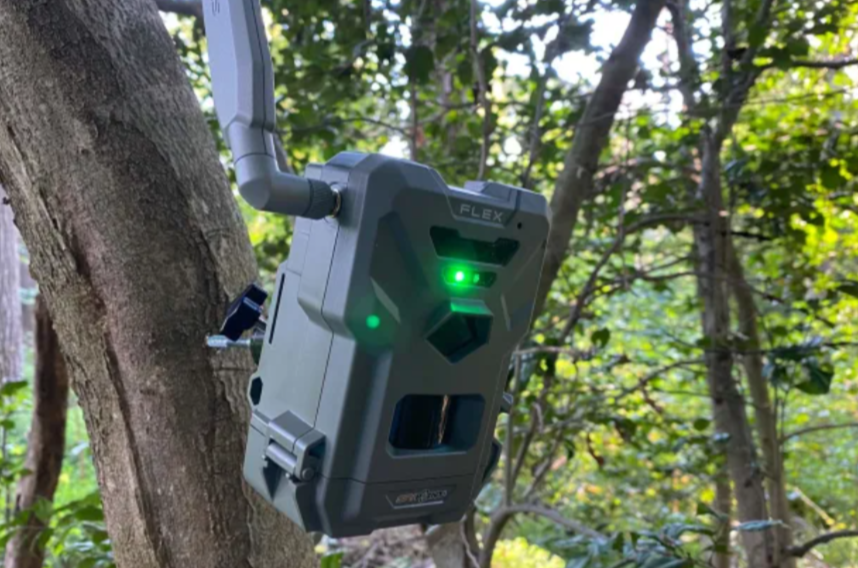
Image Source: Outdoor Life
Price: $99.99
The SpyPoint Flex G-36 is a versatile cellular trail camera that offers high-resolution imagery and flexible data plan options. It is designed for easy setup and reliable performance in various environments.
Key Features
- Captures high-resolution photos and 1080p videos.
- Runs on 8 AA batteries, designed for longevity.
- Supports microSD cards up to 512 GB for ample storage.
- Cellular connectivity with flexible data plans for remote monitoring.
- User-friendly interface for easy configuration and use.
Reolink Go Ranger PT
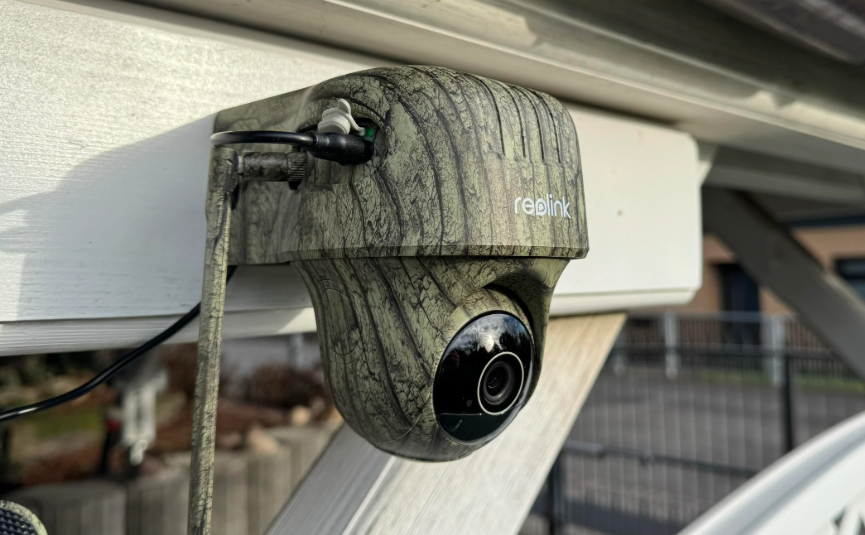
Image Source: Reddit
Price: $319.00
The Reolink Go Ranger PT is a 4K Ultra HD trail camera with 4G LTE connectivity, offering a 360° panoramic view for comprehensive monitoring. It is suitable for remote areas without Wi-Fi access.
Key Features
- Captures 4K Ultra HD videos and images.
- Rechargeable battery with solar panel compatibility for continuous power.
- Supports microSD cards up to 128 GB for storage.
- 4G LTE connectivity for live viewing and instant alerts.
- 360° pan and tilt functionality for comprehensive coverage.
How to Set Up a Trail Camera for Home Security
Here’s how to use a trail camera for security.
Choose the Right Location
For home security, you’ll want to cover entry points like front doors, driveways, backyards, and any blind spots where intruders might sneak in. Unlike traditional security cameras, trail cameras are designed to blend in with their surroundings, so mounting them on a tree, fence post, or an elevated corner of your house can keep them discreet.
Avoid placing the camera too high, as it might miss important details like faces or license plates. A height of about 5 to 7 feet is ideal for most situations.
Adjust Motion Sensitivity
Trail cameras work by detecting motion, but if the sensitivity is too high, they are triggered by small movements like leaves blowing in the wind or passing animals.
On the other hand, if the sensitivity is too low, it might miss crucial activity. Most cameras allow you to adjust this setting, so it’s best to test different levels and see what works best for your property. Positioning the camera to face an area where movement naturally occurs, such as a pathway or driveway, helps ensure it captures the right footage.
Optimize Night Vision Settings
One of the biggest advantages of a trail camera is its ability to capture clear footage at night using infrared technology. To get the best results, make sure the camera is not placed too close to reflective surfaces like glass or metal, as they can cause glare and wash out the image.
If your camera allows for infrared brightness adjustments, setting it to a medium level can prevent overexposure while still providing a clear view. If you’re monitoring a larger area, choosing a model with a long-range night vision feature will help ensure better visibility in the dark.
Secure the Camera
Since trail cameras are often placed in outdoor locations, they can be vulnerable to theft or tampering. To prevent this, consider using a security box or a cable lock to attach it to a fixed structure like a tree, fence post, or wall.
If possible, position the camera in a slightly hidden spot where it remains out of sight while still capturing the area you want to monitor. Another option is to use decoy cameras — keeping a cheap, visible camera in plain sight while the real trail camera is well-hidden nearby. This tactic can deter phrogging while ensuring you still get usable footage.
Regularly Check SD Card & Battery
Unlike traditional security cameras that store footage in the cloud, trail cameras rely on SD cards for storage. This means you’ll need to check and clear the card periodically to ensure the camera continues recording. If your camera has a loop recording feature, older footage will automatically be overwritten, but it’s still a good idea to back up important clips.
Battery life also varies depending on the model and usage, so checking the battery status regularly and replacing or recharging when necessary will keep your camera operational. Some models support external battery packs or solar panels, which can reduce the need for frequent battery changes.
Final Thoughts
A trail camera is a practical and budget-friendly way to enhance your home security, especially in areas where traditional security cameras are not an option. They offer stealth, long battery life, and reliable motion detection, which make them useful for monitoring driveways, backyards, and remote properties.
However, they do have limitations, such as lack of real-time access and storage constraints. If you need a low-maintenance security solution, a trail camera is worth considering.
Ready to find the best one for your home? Explore the best trail cameras for home security here!
FAQs
Can I use trail cameras for home security?
Yes, you can use a trail camera for home security. These cameras are battery-powered, motion-activated, and can capture high-quality images and videos — even at night. While they don’t provide real-time monitoring like security cameras, they’re a great option for discreetly recording activity around your property.
What is the difference between a trail camera and a security camera?
Trail cameras are designed for outdoor use, rely on batteries, and store footage on SD cards. On the other hand, security cameras usually connect to Wi-Fi, offer live streaming, and store footage on cloud or DVR systems. Trail cameras work well for remote locations, while security cameras provide real-time access.
How do you hide a trail camera for home security?
To hide a trail camera, place it in a discreet location like a tree, fence post, or under an eave where it blends with the surroundings. Use camouflage covers or mount it at an angle that avoids direct eye level. Positioning it in shadowed areas also helps keep it unnoticed.
Can I use my camera as a security camera?
A regular digital camera isn’t ideal for security since it lacks motion detection and automatic recording. However, some smartphones or webcams can be repurposed with security apps. Trail cameras, though, are a better alternative because they automatically capture movement and work efficiently in outdoor conditions.